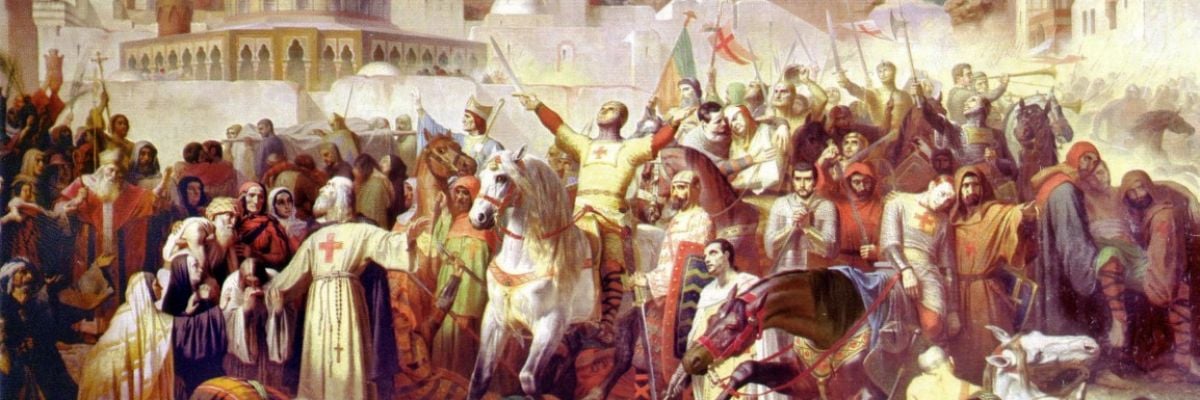
Today marks the 915th anniversary of the liberation of the Holy City of Jerusalem by the warriors of Christendom on the First Crusade. Those who entered the city in that summer of 1099 had endured three years of battle, starvation, and disease in order to complete their armed pilgrimage to the Holy Sepulchre of the Lord. Eighty percent of their brothers in arms who marched from Europe with them were dead, missing, or had deserted. Those few who remained succeeded in accomplishing the task given to them by Bl. Pope Urban II in the fall of 1095.
The liberation of Jerusalem was a momentous event. Those who returned from it were feted as heroes and known as “Jerusalemites” for the rest of their lives. The story of how the First Crusade succeeded is filled with personal heroics, sacrifice, and miraculous interventions.
Pope Urban called the First Crusade in response to the plight of the Byzantine emperor, who asked the pontiff to send warriors to the East to help fight the Seljuk Turks who were overrunning the province of Anatolia. In November 1095, Urban called upon the warriors of Christendom to liberate the Holy Sepuchlre in Jerusalem and stop the persecution of Holy Land Christians and pilgrims. It is estimated that 60,000 warriors responded to Urban’s call and made preparations to leave for the Holy Land.[1] Although many nationalities were represented on the Crusade, the vast majority of the soldiers were French.
After arriving in Constantinople and crossing the Bosphorus, the Crusaders decided to liberate the strategic city of Nicaea on the shores of the Ascanian Lake, site of ecumenical councils in 325 and 787. The siege lasted six weeks and was witness to intense fighting and horrific brutalities. The Turkish defenders tried to demoralize the living Crusaders by mutilating their dead comrades.[2] The atrocity did not have the intended effect, and with Byzantine help the steadfast Crusaders succeeded in liberating Nicaea.
After resting and refitting, the Crusader armies began the long march through the hot Anatolian sun on their way to Antioch. Food and water were scarce, and horses died in droves during what came to be called the Anatolian Death March. When fresh water was found, some men even died of hyponatremia (water intoxication) after drinking too much too fast. Adding to their suffering, the Crusaders were attacked by an allied Muslim force near the town of Dorylaeum. Despite their weakened condition, the Christian warriors fought well and defeated the Muslim army. News of the victory spread throughout the region and contributed to the belief the Christian force was invincible.
The Crusaders eventually arrived at the ancient Christian city of Antioch, defended by a massive wall, and settled in for a long siege. The city was finally breached when a Crusade leader named Bohemond managed to bribe a tower guard to allow the Crusaders into the city unmolested. And just in time—for one day later a large Muslim relief army arrived at the walls!
The besiegers were now the besieged. The fight for Antioch had been costly, and morale was low. With the arrival of the Muslim relief army, many believed this was the end of the Crusade, but God intervened (as he had throughout the campaign) and morale was restored when the relic of the Holy Lance (the spear head used by St. Longinus to pierce the Lord’s side on Good Friday) was discvored in a church.[3] Emboldened by the finding of the relic, the Crusaders launched a surprise offensive that defeated the Muslim relief army. Veterans of the battle recalled seeing angels and the spirits of dead Crusaders riding into combat with the living.[4] The Crusaders were exhausted after their miraculous victory over a numerically superior foe and spent the next several months resting and preparing for the march on Jerusalem.
The 12,000-man remnant of the First Crusade armies arrived at the city walls of Jerusalem on June 7, 1099. Its first attack failed, and it became apparent that the army had inadequate siege equipment. But ten days later the Lord once again provided when six Genoese and English ships sailed into the port city of Jaffa, carrying provisions and wood for building siege engines. As that work began, a priest named Peter Desiderius shocked the Crusaders by announcing that he had seen a vision of Bishop Adhemar, the papal legate who had died shortly after the final victory at Antioch. According to the priest, Adhemar was upset at the lack of unity among the Crusade leaders and indicated the Holy City could only fall with a show of penance.
He demanded they fast for three days and then process barefoot and unarmed around Jerusalem. A fast was proclaimed and on July 8 the Christian host processed around the Holy City singing prayers and bearing relics, including the Holy Lance from Antioch. The Muslim defenders mocked the Christians during their procession by hanging crosses over the walls while hitting and abusing them.[5]
A week of siege later on July 15, the Feast of the Dispersal of the Apostles, the Crusaders achieved their final objective and entered the Holy City of Jerusalem. 460 years from the initial capture of the city by the forces of Mohammed, the sacred sites of Jerusalem were once again in Christian hands. [6] The Crusaders’ three-year armed pilgrimage was now complete, and most returned home.
A small number stayed in order to protect, organize, and consolidate the liberated territory. In order to accomplish this they needed a strong leader, so they decided to appoint a king. The choice eventually fell to Godfrey de Bouillon, but he refused the title “king” and chose instead to be called “Defender of the Holy Sepulchre.” In explaining his choice of titles, Godfrey said that he refused to wear a crown of gold in the city where his savior wore a crown of thorns.
[1] John France, Victory in the East—A Military History of the First Crusade (New York: Cambridge University Press, 1994), 142.
[2] Fulcher of Chartres, the chronicler of the First Crusade, recorded the incident: “Truly, you would have grieved and sighed with compassion, to see them [Turks] let down iron hooks, which they lowered and raised by ropes, and seize the body of any of our men that they had slaughtered in some way near the wall. Having robbed the corpse, they threw the carcass outside.” (Chronicle, Book I, X.7 in The First Crusade—The Chronicle of Fulcher of Chartres and Other Source Materials, Second Edition edited by Edward Peters (Philadelphia: University of Pennsylvania Press, 1998), 64.)
[3] It should be noted there were at the time serious doubts about the authenticity of the purported relic, especially by the papal legate Bishop Adhemar. But the vast majority of Crusaders believed the visions and relic were authentic and their morale was significantly improved with its finding.
[4] Gesta Francorum in Peters, The First Crusade, 223.
[5] Raymond d’Aguilers in Peters, The First Crusade, 255.
[6] Much has been made of the “Massacre of Jerusalem” after the Crusaders entered the city. It is probable that anywhere from several hundred to 3,000 combatants and non-combatants were slain by the Crusaders out of the city’s population of 20,000 – 30,000. Ibn al-`Arabi, a contemporary, provides a figure of 3,000 which is accepted by Benjamin Kedar in his 2004 study “The Jerusalem Massacre of 1099 in the Western Historiography of the Crusades”, Crusades vol. 3, The Society for the Study of the Crusades and the Latin East (Burlington, VT: Ashgate Publishing Company, 2004), 75. The dictates of warfare at the time, followed by Christians and Muslims alike, allowed victorious siege armies free rein once the city fell. This is why many cities accepted conditional surrender when armies first appeared at the walls.



